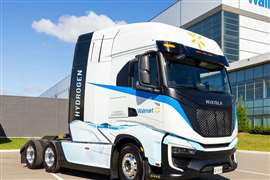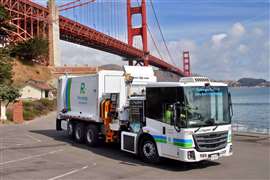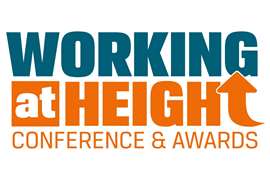Fuel cell electric buses coming to Mississauga, Ontario
30 September 2024
The Canadian Urban Transit Research & Innovation Consortium (CUTRIC) recently announced that the city of Mississauga, Ontario, Canada, has launched a hydrogen-powered bus initiative. The organization called it a groundbreaking project and said it was realized via the commercialization collaboration of CUTRIC.
In a separate press release, the city of Mississauga said it would become the first municipality in Ontario to pilot fuel cell electric buses (FCEB). The project deadline is Dec. 31, 2025, and the city is looking to purchase 10 FCEBs. Mississauga said it has set aside about CA$20 million for the 40-ft. buses, with half of that being reimbursed via Canada’s Zero Emission Transit Fund (ZETF). The city council is seeking approval to purchase the buses from manufacturer New Flyer.
 A New Flyer Xcelsior Charge FC bus. (Photo: New Flyer)
A New Flyer Xcelsior Charge FC bus. (Photo: New Flyer)
MiWay, Mississauga’s transit agency, has also requested an additional CA$500,000 for facility upgrades to support the buses.
“This CA$20 million investment will advance our understanding of hydrogen fuel and what it means for sustainable transportation options in the future,” said Carolyn Parrish, mayor of Mississauga.
Jess Smith, manager of commercialization and operations for CUTRIC, said Mississauga’s adoption of hydrogen FCEBs is important in part because of its location.
“Mississauga is located in an area where they’re in the GTHA [Greater Toronto and Hamilton Area],” they said. “So, they’re near other transit agencies. They’re near some larger commercialization transport hubs, things of that nature — main kinds of transportation routes.”
Smith said that location means there is potential for growth of FCEBs.
Alternative to Batteries
According to Smith, transit agencies see hydrogen as a viable alternative to other power solutions, such as battery electric (BE) vehicles “to address range barriers.”
They added, “This technology is a bit easier when you transition from a diesel ICE bus to a hydrogen fuel cell. It’s a bit similar in fueling. As the technology advances, it’ll be similar in range and things of that nature. So, it’s a bit easier for them [transit agencies] to envision this transition, especially when you’re looking at a longer route that many not have an opportunity to top up with charging.”
The predictable and repetitive routes make hydrogen fuel cells ideal for transit buses, Smith said. Additional benefits include lighter weight and space considerations.
“You have the smaller battery size compared to a battery electric bus,” they said. “Hydrogen is a very light fuel, so it’s very easy to be able to have a 35 kg fuel tank on a bus that’s going to supply a much smaller battery, leaving space for things like the weight of passengers.”
Fueling Options
While Smith was not at liberty to discuss the particulars of the fueling infrastructure as it was still subject to a request for information (RFI) by the city of Mississauga, they did address the choices that are available.
Addressing the Cold
Another Canadian organization, the Alberta Motor Transport Association (AMTA), has also investigated the viability of hydrogen fuel cells, but not for buses. AMTA’s focus is on heavy-duty trucks. They recently addressed their work looking at how hydrogen fuel and fuel cells performed in Canada’s extremely cold temperatures.
CUTRIC’s Jess Smith said Canadian winters were a concern when it came to the fuel cell electric buses (FCEB) being planned for Mississauga, not to mention elsewhere in the country.
“In the more northern environments, we can get cold — as much as -50°C here in Edmonton,” they said. “So, being able to see how those buses perform — at one point during this particular project, there was a bit of a concern about the cold.”
A partner on the Mississauga project is fuel cell specialist Ballard Power Systems of Burnaby, British Columbia. Smith said Ballard worked diligently on their fuel cells to be able to adapt them for the temperatures.
“That’s one of the outcomes that actually came from this project to allow Strathcona County, Edmonton, Winnipeg, other transit agencies to be able to lean into the technology,” Smith said. They added that the data coming from the pilots will also be helpful moving forward.
“And being able to again share those lessons learned and work together in a very collaborative environment,” they said, “so the transit agencies can start to lean into and trust the technology.”
“We have a few options to be able to bring the fuel to the transit agency, essentially either in a liquid or gaseous form,” Smith said. “In liquid form, you end up being able to bring a lot more at one time.”
Long term, they said, on-site electrolyzers would be especially beneficial.
“It’s a very easy way for transit agencies to be able to produce their own hydrogen,” Smith said. “They’re able to do it off high peak demand hours with the electricity. And it’s really an opportunity for them to be able to create their own little ecosystem and be able to move with a nice, low-carbon — or green, if you like — hydrogen.”
Regardless of the approach, Smith said that refueling the buses takes as little as 10 minutes via fast fill.
“It’s a very similar situation to a diesel bus that you would expect if you have multiple routes back-to-back,” they said. Smith added, “You’re able to come back to the depot or wherever you’re refueling infrastructure is and be able to top up pretty quickly.”
Other Pilot Programs
The Mississauga initiative joins other FCEBs in Canada currently being tested and others that are on the way.
“In Strathcona County and Edmonton [Alberta], they each have one bus,” Smith said. “So, there are two fuel cell buses that are in pilot right now. Those are the only buses in Canada that are in a pilot on the road right now.”
Winnipeg, Manitoba, will soon be joining them.
“They have eight fuel cell buses that they’re hoping to have onsite by the end of 2024 that are currently being manufactured,” Smith said.
The expected purchase of 10 FCEBs will make Mississauga’s investment the largest thus far in Canada.
Helping Other Agencies
As a consortium that is member owned, Smith said that part of what CUTRIC seeks to do is help other transit agencies throughout the country.
“We have the opportunity to work with project partners who are very interested, very vested in being able to do this going forward,” they said. “All of the transit agencies throughout my work with Canadian public transit agencies — it’s a very collaborative environment. Everybody wants to be able to help and support other transit agencies and lessons learned.”
Smith added that none of the transit agencies wants to go it alone with new technology.
“Being able to work with other transit agencies that are in different stages of procurement in getting fuel cell buses on the road and learning from those other transit agencies is a huge and very important part of this.”
MAGAZINE
NEWSLETTER
The gold standard in market research
Off-Highway Research offers a library of more than 200 regularly updated reports, providing forensic detail on key aspects of the construction equipment industry.
Our detailed insights and expert analyses are used by over 500 of the world’s largest and most successful suppliers, manufacturers and distributers, to inform their strategic plans and deliver profitable growth.










